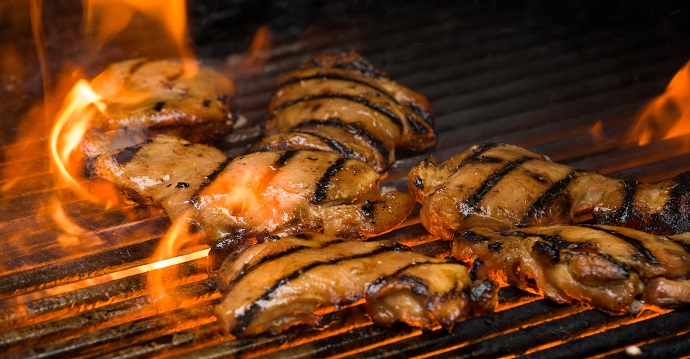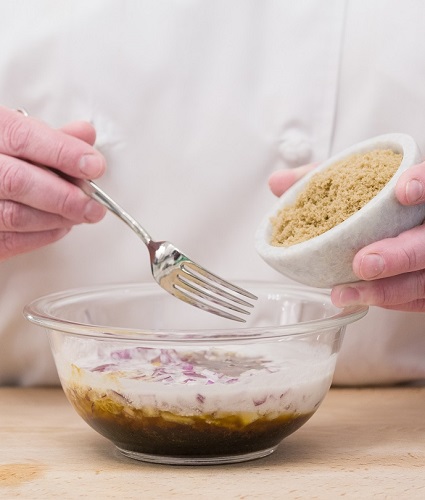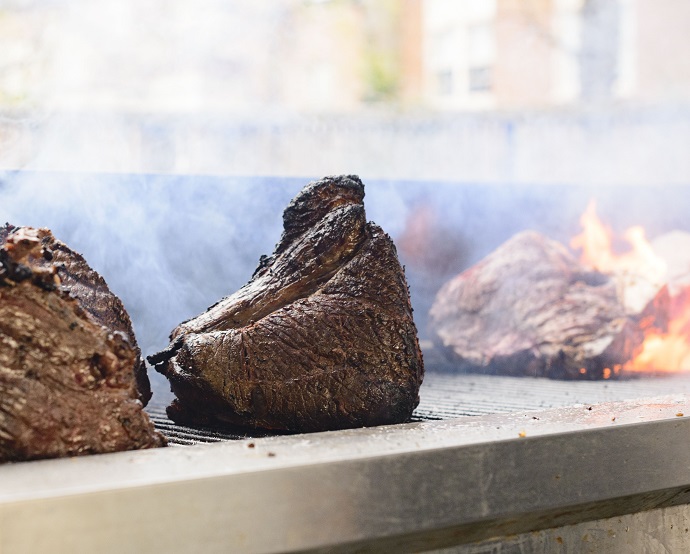Barbecues, grills, marinades, rubs, sauces—it can be hard to sort out what’s what when it comes to creating amazing summer flavor. SAGE is here to help with all of your questions—and share some delicious recipes!
What’s the difference between grilling and barbecuing?
Grilling is a quick, high-heat method. Barbecuing is cooking meat slowly over low heat in a smoker, so it’s flavored with wood smoke.
If you don’t have a smoker, don’t worry. You can make delicious barbecue with your grill—just remember to cook slowly at a low temperature.
Here’s how: Place your hot coals on one side of the grill. Atop the coals, place a perforated aluminum foil packet of woodchips to create smoke. Set your meat on the other side of the grill, so that it’s indirectly heated by the coals. Shut the lid, and let the smoke do its work!
What’s the best wood to barbecue with?
It depends on the flavor profile of your dish. Generally speaking, you’ll want to use hardwood from trees that produce an edible fruit—like cherries, apples, or acorns. Choose from one of the woods below, which you can find chipped and ready to go at a local hardware store or online.
Oak: smoky Mesquite: spicy Alder: sweet and smoky Apple: sweet and fruity Cherry: sweet and tart Hickory: strong Pecan: nutty
You can soak the chips before barbecuing if you’d like, but we’ve had equal success with dry chips. The trick is not to poke too many holes in the aluminum packet—because more airflow means more fire. You want just enough to release the flavorful smoke, but not so many that the air rushes in and burns up your chips!
What’s the difference between marinades, rubs, and sauces?
Marinades A marinade is a liquid in which foods are soaked to make meat flavorful and tender. One part acid—like wine, vinegar, or citrus juice—is the base of a marinade. Three parts oil, as well as salt, sugar, herbs, and spices, are added. A general rule of thumb is half a cup of marinade per pound of meat.
Marinate vegetables for 15 minutes to half an hour, fish and seafood for 15 minutes to an hour, poultry for half an hour to three hours, and other, denser meats for at least half an hour, up to overnight.
Safety Tips:
- Always marinate your food in the refrigerator, even if the recipe recommends room temperature—dangerous bacteria can grow in even a short period of time.
- Be sure to marinate in a nonreactive container, like glass or ceramic. An aluminum container will react with the acid and release metal into the marinade.
- Don't reuse the marinade as a basting or dipping sauce, because it can contain bacteria. Instead, make two batches—one for marinating and one for basting or dipping—or bring the used marinade to a continuous rolling boil for at least three minutes to kill the bacteria.
Recipe - Citrus Lime Mojo Marinade Yields 1½ cups
Ingredients:
1 cup canola oil 1/3 cup fresh-squeezed lime juice ½ lime, sliced 1 tablespoon fresh cilantro, chopped 2 tablespoons diced red onion 2 garlic cloves 2 teaspoons lime zest 1 teaspoon kosher salt 1 teaspoon ground black pepper
Preparation: In a blender or food processor, combine all ingredients. Refrigerate up to one week.
Rubs A rub is a mixture of herbs and spices that’s applied to meat before cooking. Dry rubs create a crisp, flavorful crust. Wet rubs (which are just dry rubs with the addition of wet ingredients, like water, vinegar, mustard, or coconut milk) help to keep the meat juicy. They’re good for food that needs extra moisture and flavor, like flank steak, white potatoes, and summer squash.
To use a rub, pat the meat dry with paper towels, then apply the rub. Let the meat sit for half an hour to an hour, then pop it on the grill. For poultry, make sure you apply the rub under the skin, directly on top of the meat.
Recipe - Carolina Barbecue Rub Yields 1¼ cups
Ingredients:
½ cup paprika 2 tablespoons chili powder 1 tablespoon ground cumin 1 tablespoon brown sugar 1 tablespoon kosher salt 1 tablespoon ground black pepper 2 teaspoons cayenne pepper
Preparation: Combine all ingredients. Stored in a tight-lidded container away from light and moisture, this dry rub will last a year or more.
Sauces The original barbecue sauce was made from vinegar and pepper, and dates back hundreds of years. Sauces vary widely by region: Kansas City barbecue is thick and sticky; melt-in-your mouth Georgian barbecue is heavy on the brown sugar; Texas brisket is dressed with a tangy, tomato-based sauce; and North Carolina barbecue has a vinegary kick. Get started with this sweet sauce—it’s made with pantry staples you probably have on hand!
Recipe - House-Made Barbecue Sauce Yields: 2 cups
Ingredients:
¼ cup chopped onion 1 teaspoon vegetable oil 2 cups ketchup 2 tablespoons brown sugar 2 teaspoons onion powder 1 teaspoon granulated garlic 1 teaspoon salt ½ teaspoon ground black pepper
Preparation:
- In a medium saucepan, sauté onions in oil until translucent.
- Add remaining ingredients; simmer uncovered for one hour, stirring frequently.
- Cool and store in refrigerator until ready to use.
Look out for Thursday’s article on grilling tips and tricks, straight from our SAGE Chefs!










